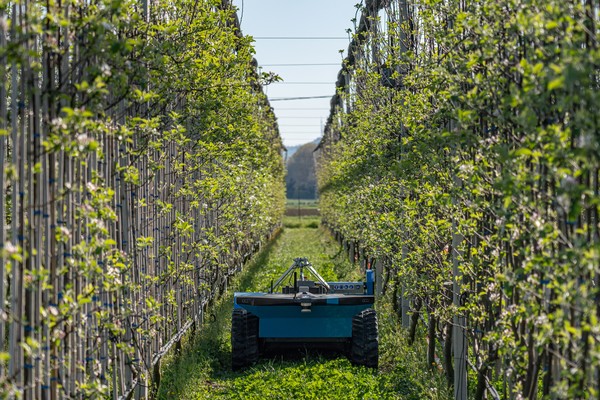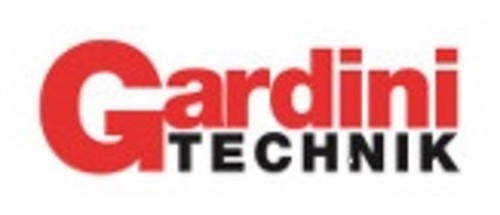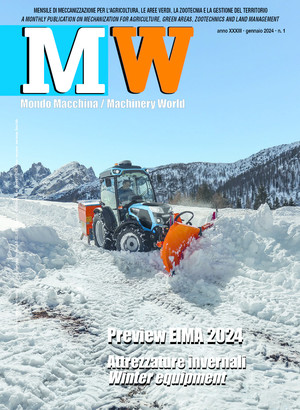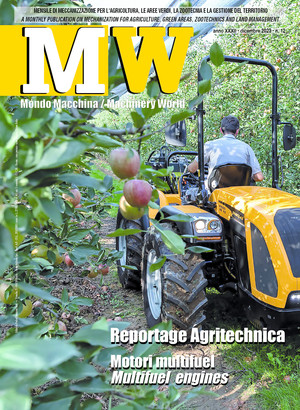
Autonomous agricultural robots, the novelties of manufacturers
Despite several regulatory gaps that risk creating uncertainty among manufacturers, the agricultural sector is increasingly opening up to the use of autonomous machines; they are fundamental to optimise the use of production factors and to improve the sustainability of the primary sector
FAO estimates that global demand for agricultural products and food will grow by 50 percent by 2050, when the world's population is expected to increase from 8 billion to just under 10. In anticipation of a continuous growth in demand for food, the agriculture of the future is called upon to win a great challenge: to further increase productivity in the face of a decrease in inputs. It is now well established that the development of automation in agriculture, especially in protected crops, can contribute enormously to making food production more efficient and environmentally sustainable. The first step towards total robotization is undoubtedly represented by the possibility of being able to use numerous models of autonomous tractors equipped with GPS, artificial intelligence sensors, which, although in some operating areas they do not yet reach human capabilities, in terms of precision in maintaining certain trajectories are already more performing than the best tractors. The rapid evolution in the field of sensors and artificial intelligence will soon make machines equipped with this new technology increasingly able to reach human operational capabilities. Even in situations where a lot of experience is needed to make sensible operational decisions, the man-machine gap will therefore become increasingly narrower.
For more than 20 years there have been tractors on the market that are able to follow, with extreme precision, predetermined tracks, as well as to turn and repeat at the headland a precise sequence of commands, also cadencing the time interval between one command and another. From here to market such machines, however, without a driver's cab and, therefore, fully automated, the step is very short: in fact, there are companies that have already done so. However, a significant problem remains: making the machine able to react to multiple unexpected events and the variability of situations that may arise in the field. In reality, several manufacturers, university research centres and start-ups are already able to build autonomous machines designed to react correctly to obstacles, but the development of the market for highly automated machines is being held back by some regulatory gaps that need to be filled quickly. An example of this regulatory vacuum is that in the vast majority of countries in the world, including the European Union, it is not yet clear who should be held responsible for a possible accident caused by a highly automated vehicle.
The lack of a specific rule, in this case regulating autonomous driving, is caused by the marked delay with which regulatory adaptation pursues technological progress, as demonstrated by the delay with which legislation on the Internet phenomenon has been reached.
Some European and international bodies are working to solve this problem. These include the French laboratory LNE (Laboratoire National de métrologie et d'Essais), a reference point for the measurement, testing and certification of products of all kinds; CEMA (European Committee of Associations of Agricultural Machinery), which also includes FederUnacoma and the OECD (Organization for Economic Cooperation and Development). It should be noted that in the automotive sector the legislation relating to autonomous driving has already been addressed, although to date among all European Union countries only in Germany has been authorised the approval of a car that can drive autonomously on the highway at speeds not exceeding 60 km/h.
While waiting for the regulatory framework to be clarified and the doubts of manufacturers to be resolved, some brands have already presented several highly automated systems to the public. Some are still in “concept” form, others have only been engineered, others are already commercialised. The different solutions present or ready to enter the market differ fundamentally in size and shape. While some of them are very similar to traditional agricultural tractors, with which the use of diesel fuel as an energy source is almost always in common, others have very few common characteristics with the machines we are used to seeing in the field. Sometimes they are recognisable only by the presence of wheels or tracks, and very often employ for their operation the electrical energy stored in batteries brought on board, while more rarely they also exploit photovoltaic panels to increase their autonomy. Finally, there is another type of small or very small agricultural robots, characterised by low operational capabilities, but still able to cooperate with each other to act on the fields as a sort of swarm.
To the “traditionalist” vein, as such robots resembling ordinary agricultural tractors are understood, belong most of the proposals from the historic manufacturers, including those proposed by the AgCo and CNH groups, but also by brands such as John Deere, Yanmar and Kubota. The technical solutions proposed by these brands are based, in almost all cases, on the same mechanical components as the tractors normally in production; it is no coincidence that most of these models are in fact common high-end tractors, powered by a Diesel engine and equipped with all modern satellite automatic guidance technologies. However, there are also prototypes, such as the Sesam 2 by John Deere, with power supply and a 1,000 kWh battery, and without a cab (which can still be installed for road transfers). Also by John Deere is the 8R 410 tractor, identical in appearance to the traditional 8R (i.e. equipped with a cab), which is also the first fully autonomous tractor to be marketed in North America with list prices ranging from 500 thousand to 800 thousand dollars. Also without a cab is the CASE-IH prototype based on a Magnum Cvx, which, in addition to the satellite signal, exploits data from a series of cameras and radars that detect any obstacles. The New Holland NH Drive tractor-robot is almost identical to the normal T8 Blue Power: this allows you to operate with driver on board to perform all those operations for which driverless driving is not yet possible. The CNH Group is investing heavily in this sector and has recently committed large sums to California-based Monarch Tractor, which designed the 52 kW electric-powered Mk-V tractor. Also in this case it is a driverless tractor, but with a driving platform, intended for operation in vineyards and orchards. Among the first tractors in the world to be used without a driver on board are the Valtra, which have been operating commonly and for many years at the Swedish airport of Ivalo (the northernmost in the world) for snow removal. Belarus is also working in the same direction. One example is the Belarus A3523i, an autonomous tractor without a cab, powered by a 350-horsepower Cummins engine and featuring a special continuously variable transmission with electric motors. Japan's Yanmar developed the YT5113A model based on the standard YT5113N model, but it is stripped of the cab to create the space needed for autonomous technology hardware and chemical tanks. Recently unveiled is the prototype MR 1000A Agri Robo KVT by Kubota, an autonomous tractor developed on the Kubota M5112 model platform, with which it shares many of its components, as well as the cab.
Reviewing instead the proposals that have different conformations than those of traditional tractors, you come across mostly (but not only) a large number of solutions developed by small companies or startups, although, as usual, there are exceptions. An interesting showcase for these solutions was the last edition of FIRA in Toulouse where there were 30 agricultural robots on display, of which 20 were operating in the demo area. One of the most interesting machines seen at FIRA is certainly Orio, which enriches the range of agricultural robots proposed by French company Naïo Technologies. Orio is a tool-carrying robot powered by interchangeable packs of 21 or 32 kWh lithium batteries that drive 4 electric motors placed on the wheels. The same company also exhibited the model called TED, an electric straddle robot that has been commercialised since 2022 and is intended to operate on espalier vineyards. Also from Naïo Technologies is the tracked robot Jo, available on the market since 2023 and intended to work in vineyards with slopes of up to 40%. Worthy of interest and “outside the box” is Robot One, proposed by the Dutch Pixelfarming Robotics, capable of carrying out weed control operations with a futuristic laser beam, with special finger weeders to clear weeds or with more traditional ridgers that cut roots. An all-Italian proposal comes from Field Robotics, a start-up founded in 2022 with the FR-01, an electric, robotic and modular tool carrier, equipped with interchangeable orchard equipment and equipped with rechargeable 24 or 48 kWh lithium batteries. It is a prototype, which can only be combined with a shredder and an atomizer, but during this year it will also be proposed with new combinations, and then be launched on the market from next summer. Also interesting is the full electric prototype developed by Israeli start-up Nanovel, which is used to harvest fruits such as citrus fruits, stone fruit and tropical fruits thanks to vision systems, artificial intelligence algorithms and special arms equipped with Grip & Tri technology. This prototype should be commercially available as early as this year.
Definitely futuristic, if only for the choice of using hydrogen as an energy source and fuel cells for its transformation into electricity, is the Traxx Concept H2 from French Exxact Robotics. Already offered in the more classic version with Diesel engine, Traxx Concept H2 has the usual straddle architecture typical of vineyard machines developed in France and can be dedicated to tillage with different accessories. In addition, it can carry out phytosanitary treatments using a special sprayer with recovery panels.
Weta Robot, developed by the Iberian Teyme Group with the contribution of several Italian, Spanish, Portuguese and Dutch companies, is a prototype electric tool carrier intended for operation even on steep slopes and in narrow vineyards, and is already able to carry out variable rate phytosanitary treatments with individually controlled nozzles equipped with PWM (Pulse Wide Modulation) technology.
Also worth mentioning are the three different robotic solutions proposed by the Dutch startup AgXeed, in which the German CLAAS has recently invested by increasing its stake; it is specifically a 155 kW half-track and two Ag-bots, three and four wheels, 55 kW, respectively for vineyard and open field.
To the last type of agricultural robots, those capable of operating as swarms, belong many prototypes developed by research institutions or start-ups, but most of them are not yet suitable for commercialisation.
Among the most interesting projects and closest to market launch are Fendt’s small Xaver field robots, developed following an EU-funded project called MARS (Mobile Agricultural Robot Swarms) and carried out in collaboration with Ulm University of Applied Sciences.
In conclusion, it must be considered that although robotics and artificial intelligence technology can already provide us with infrastructure and methods to radically transform agricultural work, it is essential that new technologies are made accessible on a large scale and that the primary sector relies on a highly qualified workforce to manage technological innovation processes in this context.








